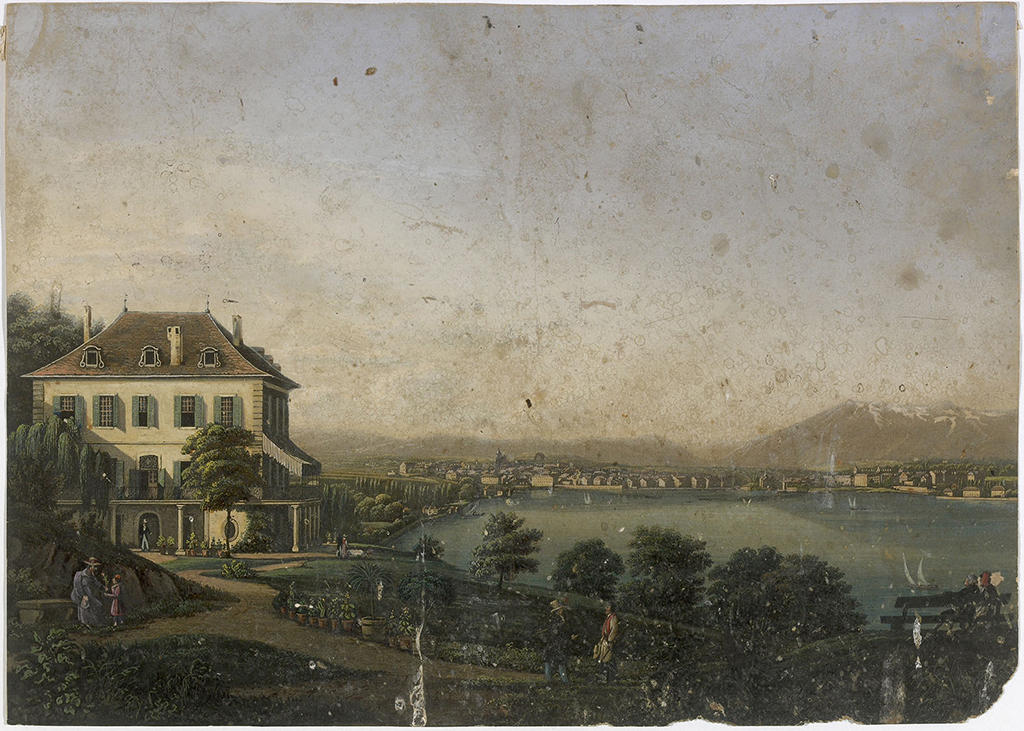Creating Frankenstein, the Lake Geneva monster

The idea for what is often called the first science fiction novel was born on the shores of Lake Geneva, in the "year without a summer".
But were Mary Shelley to write Frankenstein today, it might have more to do with Geneva being considered by many as a creature of globalisation.
Set in beautiful landscaped gardens, the Villa Diodati, where Shelley was inspired to write the novel, is a magnificent sight – even more so on a warm, cloudless spring day. How Shelley must have longed for such perfect conditions.
“But it proved a wet, ungenial summer, and incessant rain often confined us for days to the house,” she recorded in the diary she kept of her six-week summer tour of Europe in 1816.
As you wander down the Chemin de Ruth today, away from Cologny’s town hall, the narrow road with stonewalls on either side swings round, opening up a magnificent view of the lake. Here on a bend is the privately owned villa.
Uninterrupted views stretch across the water in all directions. To the left lies Geneva and the Jet d’Eau, straight ahead the United Nations buildings, and out of view just a little further along the lakeshore are the headquarters of the World Economic Forum.
It would have been impossible for Shelley to foresee that so many decisions affecting global politics would later be made on these shores.
Her thoughts, and those of the romantic poets, Lord Byron and her betrothed Percy Shelley, were consumed by the abrupt climactic changes brought on by the massive volcanic eruption thousands of miles away on the island of Sumbawa in southeast Asia.
Big chill
“[It] involved more rapid changes of atmosphere than I ever recollect to have observed before,” Shelley said of a day spent travelling on the lake.
“The morning was cold and wet; then an easterly wind, and the clouds hard and high; then thunder showers, and wind shifting to every quarter; then a warm blast from the south, and summer clouds hanging over the peaks, with bright blue sky between.”
What Europeans did not know then was that the Tambora volcano had ejected a million-and-a-half metric tons of dust into the upper atmosphere, blocking the sun and causing temperatures to drop around the world.
Forced to remain indoors in their rented accommodation, the poets sought ways to pass the time. Shelley wrote that “some volumes of ghost stories, translated from the German into French, fell into our hands”.
The group had apparently also been discussing the experiments by Erasmus Darwin (Charles Darwin’s grandfather) with galvanism, the contraction of muscles stimulated by electricity.
The ghost stories were from the book Fantasmagoriana and the writers and poets threw down the gauntlet to see who could conceive the most fantastic tale of horror. The rest is literary history…
It’s alive!
“I busied myself to think of a story – a story to rival those which had excited us to this task. One which would speak to the mysterious fears of our nature, and awaken thrilling horror – one to make the reader dread to look round, to curdle the blood, and quicken the beatings of the heart,” Shelley wrote.
Most of the entourage were successful, including Byron’s personal physician, John Polidori, who penned “The Vampyre”, which would influence Bram Stoker’s “Dracula”.
The 19-year-old Shelley however had to admit failure. “‘Have you thought of a story?’ I was asked each morning, and each morning I was forced to reply with a mortifying negative.”
But before it was over, the nightmare summer would lead to a bad waking dream.
“When I placed my head upon my pillow, I did not sleep, nor could I be said to think… I saw – with shut eyes, but acute mental vision – I saw the pale student of unhallowed arts kneeling beside the thing he had put together.
“I saw the hideous phantasm of a man stretched out, and then, on the working of some powerful engine, show signs of life, and stir with an uneasy, half-vital motion. Frightful must it be; for supremely frightful would be the effect of any human endeavour to mock the stupendous Creator of the world.”
What would result, a year later, was a full-blown novel with elements from the Gothic and Romantic periods, and was seen as a reaction to the Industrial Revolution and what could go wrong. It is also laced with references to John Milton’s “Paradise Lost”.
Milton had also visited the Villa Diodati during his European tour more than a century and a half previously.
The life of the Shelleys was marked by tragic events upon their return to Britain. Before the year of their European tour was out, Mary Shelley’s half-sister and Percy Shelley’s first wife would commit suicide.
Over the following years, two of the couple’s three children would die, and, having moved to Italy, Percy Shelley would drown at sea while travelling up the Italian coast.
Without the financial means to remain on the continent, Mary Shelley returned home, where she continued to write and edit her late husband’s work.
She died of cancer in London in 1851.

In compliance with the JTI standards
More: SWI swissinfo.ch certified by the Journalism Trust Initiative

You can find an overview of ongoing debates with our journalists here. Please join us!
If you want to start a conversation about a topic raised in this article or want to report factual errors, email us at english@swissinfo.ch.